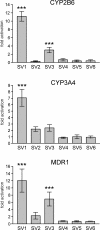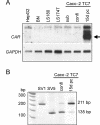Alternative splicing affects the function and tissue-specific expression of the human constitutive androstane receptor
- PMID: 15043764
- PMCID: PMC406421
- DOI: 10.1186/1478-1336-2-1
Alternative splicing affects the function and tissue-specific expression of the human constitutive androstane receptor
Abstract
BACKGROUND: The constitutive androstane receptor (CAR) plays a key role in the control of drug metabolism and transport by mediating the phenobarbital-type induction of many phase I and II drug metabolizing enzymes and drug transporters. RESULTS: We identified transcripts generated by four different alternative splicing events in the human CAR gene. Two of the corresponding ligand binding domain isoforms demonstrated novel functional properties: First, CAR(SV3), which is encoded by a transcript containing an lengthened exon 7, differentially transactivated target gene promoters. Second, CAR(SV2), which results from the use of an alternative 3' splice site lengthening exon 8, showed ligand-dependent instead of constitutive interaction with coactivators. Furthermore, alternatively spliced transcripts demonstrated a tissue-specific expression pattern. In most tissues, only transcripts generated by alternative splicing within exon 9 were expressed. The encoded variant demonstrated a loss-of-function phenotype. Correct splicing of exon 8 to exon 9 is restricted to only a few tissues, among them liver and small intestine for which CAR function has been demonstrated, and is associated with the induction of CAR expression during differentiation of intestinal cells. CONCLUSION: Due to their specific activities, CAR variant proteins SV2 and SV3 may modulate the activity of reference CAR(SV1). Furthermore, we propose that transcriptional activation and regulation of splicing of exon 9 may be coupled to ensure appropriate tissue- and differentiation state-specific expression of transcripts encoding functional CAR protein. Altogether, alternative splicing seems to be of utmost importance for the regulation of CAR expression and function.
Figures







Similar articles
-
Expression of constitutive androstane receptor splice variants in human tissues and their functional consequences.J Pharmacol Exp Ther. 2004 Nov;311(2):811-21. doi: 10.1124/jpet.104.069310. Epub 2004 Jun 11. J Pharmacol Exp Ther. 2004. PMID: 15194709
-
Expression of constitutive androstane receptor splice variants in rat liver and lung and their functional properties.Biol Pharm Bull. 2005 Nov;28(11):2058-62. doi: 10.1248/bpb.28.2058. Biol Pharm Bull. 2005. PMID: 16272689
-
Identification of novel alternative splice variants of human constitutive androstane receptor and characterization of their expression in the liver.Mol Pharmacol. 2004 Mar;65(3):496-502. doi: 10.1124/mol.65.3.496. Mol Pharmacol. 2004. PMID: 14978227
-
[Structure and Function of the Nuclear Receptor Constitutive Androstane Receptor].Yakugaku Zasshi. 2016;136(2):297-308. doi: 10.1248/yakushi.15-00215. Yakugaku Zasshi. 2016. PMID: 26831808 Review. Japanese.
-
Functional regulation of alternatively spliced Na+/Ca2+ exchanger (NCX1) isoforms.Ann N Y Acad Sci. 2002 Nov;976:187-96. doi: 10.1111/j.1749-6632.2002.tb04740.x. Ann N Y Acad Sci. 2002. PMID: 12502560 Review.
Cited by
-
Carboxymefloquine, the major metabolite of the antimalarial drug mefloquine, induces drug-metabolizing enzyme and transporter expression by activation of pregnane X receptor.Antimicrob Agents Chemother. 2015 Jan;59(1):96-104. doi: 10.1128/AAC.04140-14. Epub 2014 Oct 13. Antimicrob Agents Chemother. 2015. PMID: 25313206 Free PMC article.
-
Allosteric pathways in nuclear receptors - Potential targets for drug design.Pharmacol Ther. 2018 Mar;183:152-159. doi: 10.1016/j.pharmthera.2017.10.014. Epub 2017 Oct 31. Pharmacol Ther. 2018. PMID: 29080700 Free PMC article. Review.
-
RNA Sequencing Reveals Age and Species Differences of Constitutive Androstane Receptor-Targeted Drug-Processing Genes in the Liver.Drug Metab Dispos. 2017 Jul;45(7):867-882. doi: 10.1124/dmd.117.075135. Epub 2017 Feb 23. Drug Metab Dispos. 2017. PMID: 28232382 Free PMC article.
-
Transcription coactivator peroxisome proliferator-activated receptor-binding protein/mediator 1 deficiency abrogates acetaminophen hepatotoxicity.Proc Natl Acad Sci U S A. 2005 Aug 30;102(35):12531-6. doi: 10.1073/pnas.0506000102. Epub 2005 Aug 18. Proc Natl Acad Sci U S A. 2005. PMID: 16109766 Free PMC article.
-
Differential effects of clinically used derivatives and metabolites of artemisinin in the activation of constitutive androstane receptor isoforms.Br J Pharmacol. 2012 Oct;167(3):666-81. doi: 10.1111/j.1476-5381.2012.02033.x. Br J Pharmacol. 2012. PMID: 22577882 Free PMC article.
References
-
- Honkakoski P, Sueyoshi T, Negishi M. Drug-activated nuclear receptors CAR and PXR. Ann Med. 2003;35:172–182. - PubMed
LinkOut - more resources
Full Text Sources

